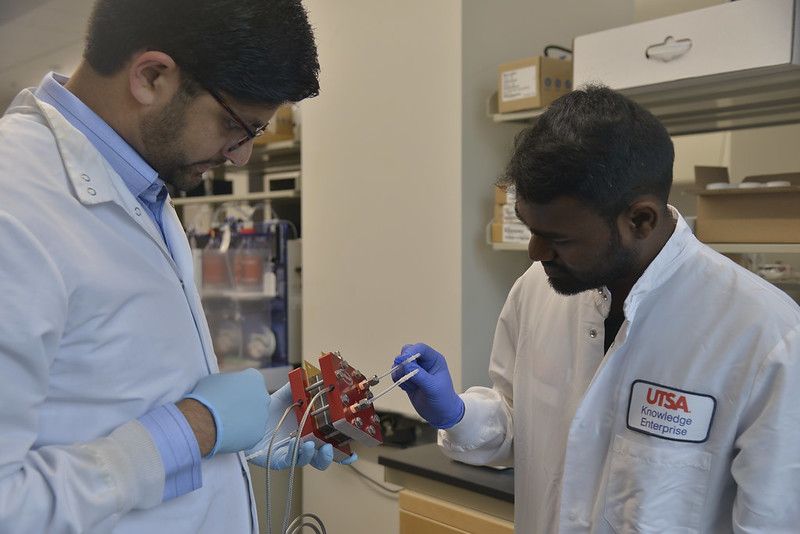Posted on August 15, 2025 by Katrina Kehoe

Vijay Vaiyadurai, PhD Fellow works alongside Sankarasubramanian for this project
AUGUST 15, 2025 - The University of Texas at San Antonio (UTSA), in collaboration with Southwest Research Institute (SwRI), has been awarded $500,000 through NASA’s TechLeap Prize program to flight-test a novel electrolyzer technology that could support future human missions to the moon, Mars and other planetary bodies.
Shrihari “Shri” Sankarasubramanian leads the Mars Atmospheric Reactor for Synthesis of Consumables (MARS-C) project. Sankarasubramanian, an assistant professor in UTSA’s Department of Biomedical and Chemical Engineering with Kevin Supak and Eugene Hoffman of SwRI are working to develop and test an advanced electrolyzer system designed to convert planetary resources into critical compounds such as fuel and oxygen.
NASA’s TechLeap Prize program is designed to accelerate the development and testing of technologies addressing specific challenges in spaceflight. The project is one of 10 selected nationally out of more than 200 entries and is expected to complete its flight demonstration within one year of the award.
At the center of their project is a patent-pending electrolyzer created by Sankarasubramanian and his research group, with earlier support from NASA. The device uses electricity to convert simulated Martian brine and carbon dioxide into methane, other hydrocarbons and oxygen. This process is a key step in enabling missions that rely on in-situ resource utilization, which allows spacecraft and astronauts to use the materials already available on planetary surfaces.
“This technology allows us to live off the land, converting what is naturally available on other planets into essential resources that support human life and mission success,” Sankarasubramanian said. “By producing fuel and oxygen on site, we can reduce payload mass, increase safety, and make space exploration more sustainable. This technology can also be used on Earth to produce fuel in remote locations and to capture and reuse emitted carbon dioxide.”
“Of course, none of this would be possible without the great team of postdocs and graduate students in my group and the support of my department and Klesse College,” Sankarasubramanian said. “One of the graduate students advancing this technology, Vijay Vaiyadurai has been supported through a Klesse Chemical Engineering Ph.D. Fellowship and such investments are allowing us to compete successfully for these federal programs.”
The team will work to integrate the device into an existing flight rig to understand better how the electrolyzer performs in space-like conditions. It will be tested during a parabolic flight, which simulates the reduced gravity environments of the moon and Mars. The flight will capture video footage of bubble formation and fluid motion inside the electrolyzer, providing critical insights into how gravity affects electrochemical processes.
This testing phase builds on previous SwRI research that investigated how fluids behave under partial gravity. The team is preparing for the next step in making space-based fuel production a reality with UTSA leading the electrolyzer technology development and driving the experimental design.
Ground testing of the flight rig will take place before the parabolic flight, which is scheduled for 2026. These tests will help the team refine operating procedures and ensure successful performance in flight.
This project highlights UTSA’s growing leadership in space technology, energy systems, and sustainable engineering. It also reflects the university’s strong commitment to applied research addressing global and interplanetary challenges.

